Home Loan Market Size
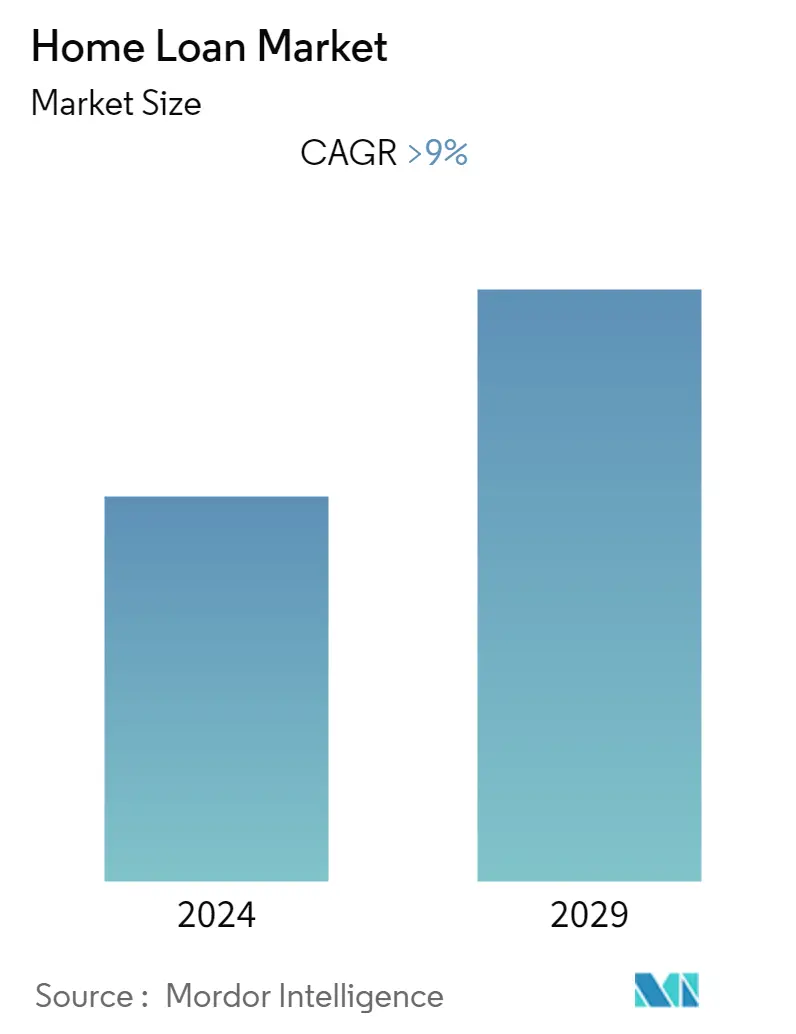
| Study Period | 2020 - 2029 |
| Base Year For Estimation | 2023 |
| Forecast Data Period | 2024 - 2029 |
| Historical Data Period | 2020 - 2022 |
| CAGR | 9.00 % |
| Market Concentration | Medium |
Major Players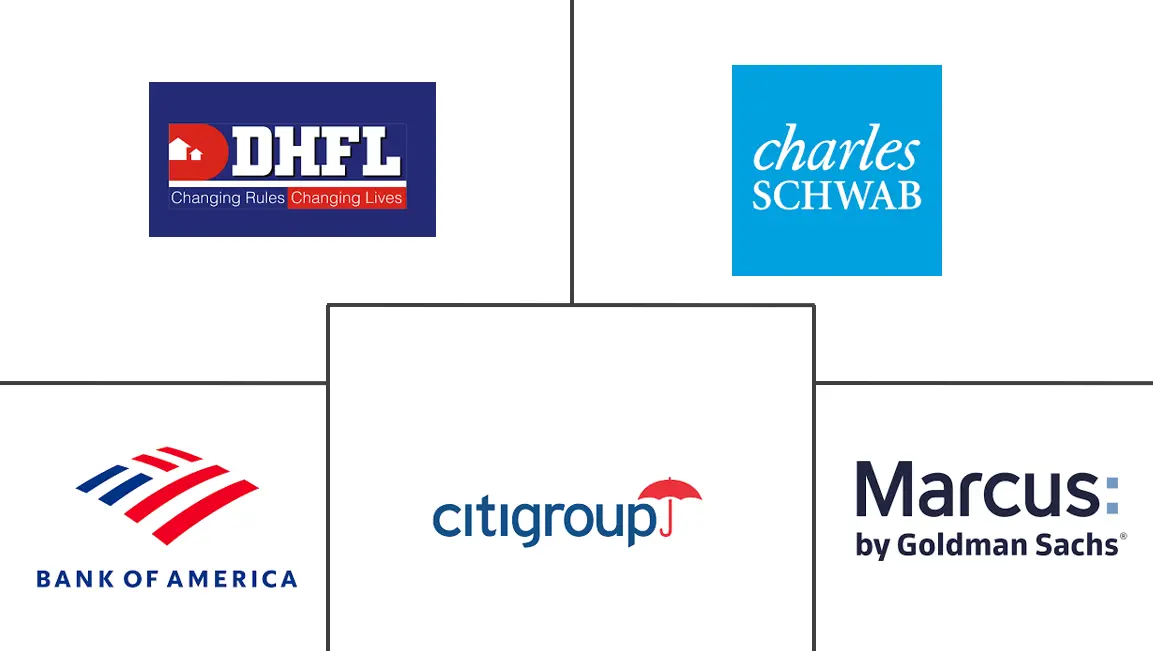
*Disclaimer: Major Players sorted in no particular order |
Home Loan Market Analysis
Home Loan Market has generated a revenue of USD 13000 billion in the current year and is poised to achieve a CAGR of 9% for the forecast period. The home loan market varies across regions due to differences in economic conditions, regulatory frameworks, cultural factors, and housing market dynamics. Developed countries often have well-established home loan markets with extensive banking systems, while emerging economies may have less developed mortgage markets. Commercial banks, including global banking institutions, play a significant role in the home loan market. They offer a range of mortgage products and services to borrowers.
Non-banking financial institutions and specialized mortgage lenders also participate in the home loan market. These lenders often focus solely on mortgage lending and may offer more specialized loan products. In many countries, government-sponsored enterprises or agencies facilitate home loan financing. Examples include Fannie Mae and Freddie Mac in the United States.
With the rise of financial technology, online lenders have emerged as alternative sources of home loans. These digital platforms provide convenient and often streamlined application processes. Changes in interest rates significantly impact the home loan market. Lower interest rates tend to stimulate borrowing activity, while higher rates can discourage borrowing. Economic factors such as employment rates, inflation, and GDP growth affect the overall demand for home loans. A robust economy with stable employment often increases demand for housing and home loans.
Government policies and regulations related to the housing market, mortgage lending, and interest rates can significantly impact the global home loan market. Policies aimed at promoting homeownership or regulating lending practices can influence market dynamics. The state of the real estate market, including property prices and housing supply, plays a crucial role in the home loan market. Market conditions can affect affordability and borrower demand.
The COVID-19 pandemic created substantial market volatility and uncertainty. Housing markets experienced fluctuations, with varying impacts depending on local conditions. Some regions witnessed a slowdown in home sales and construction activity, while others experienced increased demand for housing due to changing work-from-home dynamics.
Home Loan Market Trends
Turkey has the Highest Mortgage Interest Rate
Turkey had the highest mortgage interest rates, which would have significant implications for the home loan market and the overall real estate sector in the country. state-owned banks have dominated the housing finance market in Turkey. Mortgage interest rates and house prices are undoubtedly significantly essential elements of any housing market and driving housing demand and supply factors. Due to sharp increases in raw materials globally and also supply problems, the construction sector slowed down while prices increased dramatically. Mortgage interest rates in Turkey are average four times higher than those in the US, which is the leading country in terms of its primary and secondary mortgage market sizes globally. On the other hand, the mortgage market share in GDP is too low in Turkey compared to other countries with well-developed mortgage systems.
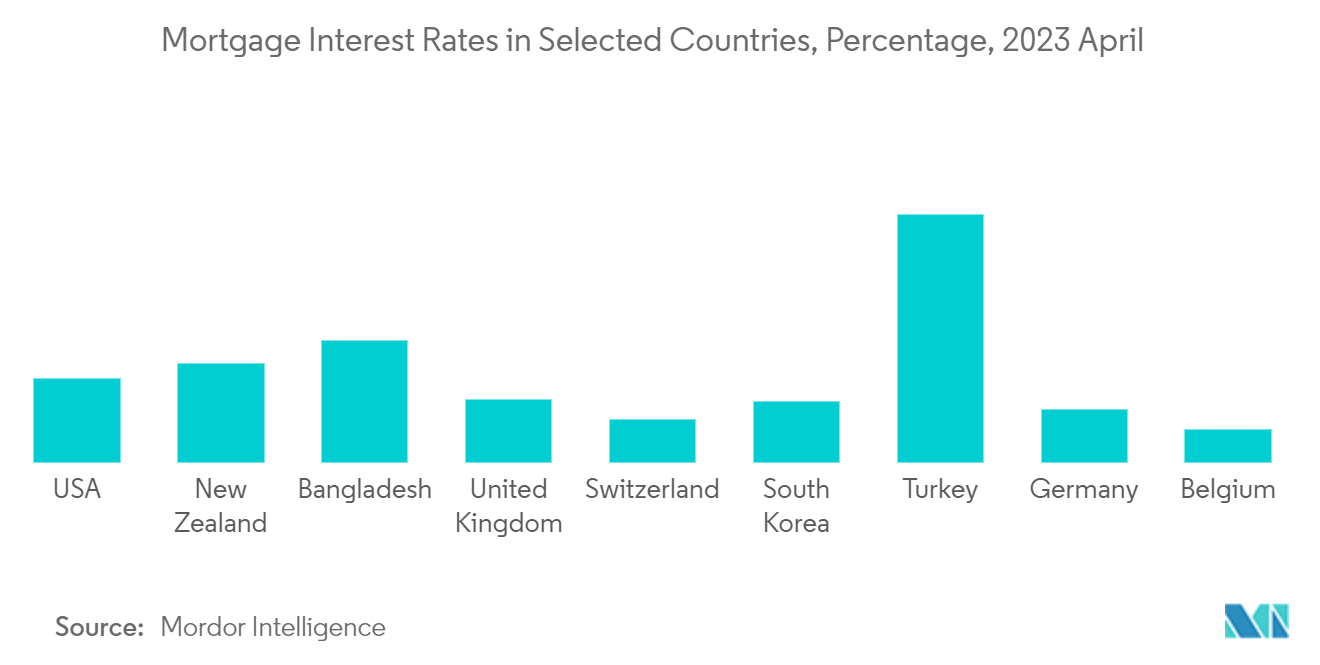
House Prices grew Faster than Incomes in Most of the Countries.
Rapid urbanization and population growth in certain areas have increased the demand for housing. This increased demand, coupled with limited land availability and regulatory constraints, lead to higher prices. Persistently low-interest rates in many countries have made borrowing more affordable, increasing demand for housing. This increased demand can drive up prices, especially in areas with limited supply. Real estate is often seen as an attractive investment option, leading to increased investment and speculation in the housing market. This can drive up prices, particularly in popular or desirable locations. Government policies and regulations related to zoning, land use, construction permits, and taxation can impact housing supply and affordability. In some cases, these policies may contribute to the rising prices relative to incomes.
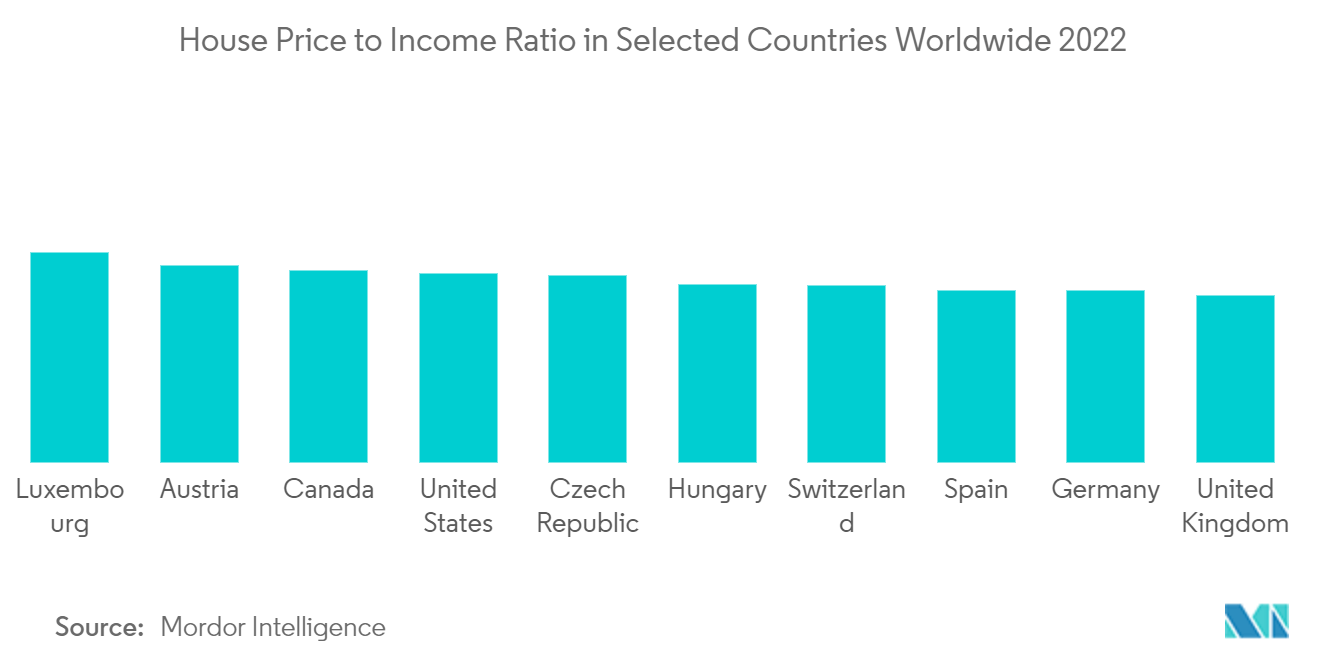
Home Loan Industry Overview
The Global home loan market is highly competitive, with numerous players vying for market share. The competitive landscape of the market is influenced by various factors, including the size and financial strength of the institutions, their market presence, product offerings, customer service, and technological capabilities. Market participants continually strive to differentiate themselves by offering competitive interest rates, flexible terms, efficient processes, and personalized customer experiences. A complete background analysis of the Home Loan Market, which includes an assessment of the economy, market overview, market size estimation for key segments, emerging trends in the market, market dynamics, and key company profiles are covered in the report. Home Loan Market is offered by top companies such as Bank of America Corporation, Charles Schwab & Co., Citigroup, Inc., Dewan Housing Finance Corporation Limited, Goldman Sachs (Marcus), HSBC Group, JPMorgan Chase & Co., LIC Housing Finance Limited, Morgan Stanley, Wells Fargo & Co.
Home Loan Market Leaders
-
Bank of America Corporation
-
Charles Schwab & Co.
-
Citigroup, Inc.
-
Dewan Housing Finance Corporation Limited
-
Goldman Sachs (Marcus)
*Disclaimer: Major Players sorted in no particular order
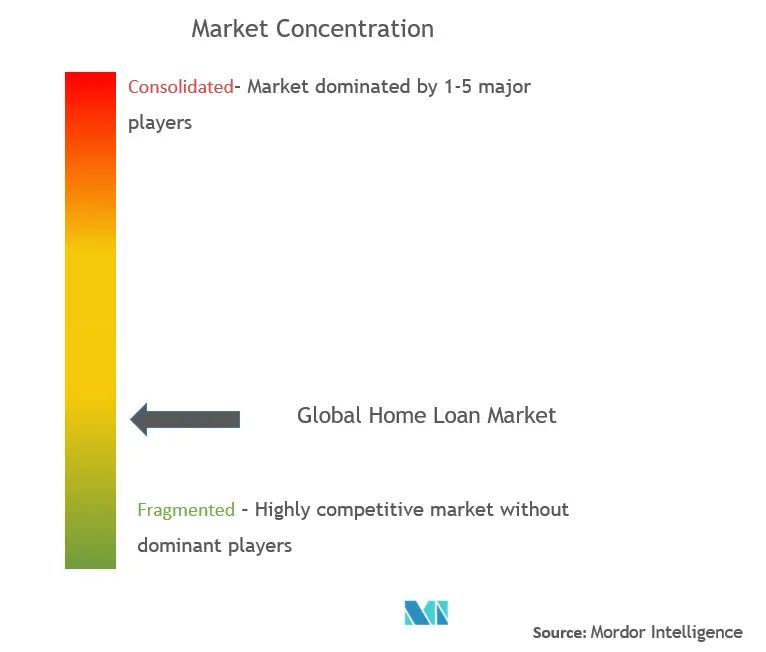
Home Loan Market News
- September 2022: Citigroup Inc said it has slightly trimmed its mortgage workforce, due to an internal streamlining of functions.Less than 100 positions were affected.
- September 2022: Bank of America is launching a new mortgage product that would allow first-time homebuyers to purchase a home with no down payment, no mortgage insurance and zero closing costs.It will not require a minimum credit score and will instead consider other factors for eligibility.
Table of Contents
1. INTRODUCTION
- 1.1 Study Assumptions and Market Definition
- 1.2 Scope of the Study
2. RESEARCH METHODOLOGY
3. EXECUTIVE SUMMARY
4. MARKET DYNAMICS AND INSIGHTS
- 4.1 Market Overview
-
4.2 Market Drivers
- 4.2.1 Real Estate Market Trends
- 4.2.2 Government Policies
-
4.3 Market Restraints
- 4.3.1 Interest rates on Home Loans
- 4.3.2 Market Volatility and Uncertainty
- 4.4 Insights on Various Regulatory Trends Shaping the Market
- 4.5 Insights on impact of technology in the Market
-
4.6 Industry Attractiveness - Porters' Five Forces Analysis
- 4.6.1 Threat of New Entrants
- 4.6.2 Bargaining Power of Buyers
- 4.6.3 Bargaining Power of Suppliers
- 4.6.4 Threat of Substitutes
- 4.6.5 Intensity of Competitive Rivalry
- 4.7 Impact of COVID-19 on the Market
5. MARKET SEGMENTATION
-
5.1 By Purpose
- 5.1.1 Home Purchase
- 5.1.2 Refinance
- 5.1.3 Home Improvement
- 5.1.4 Construction
- 5.1.5 Other
-
5.2 By End User
- 5.2.1 Employed Individuals
- 5.2.2 Professionals
- 5.2.3 Students
- 5.2.4 Entrepreneur
- 5.2.5 Others (Homemaker, Unemployed, Retired, etc.)
-
5.3 By Tenure
- 5.3.1 Less Than 5 years
- 5.3.2 6-10 years
- 5.3.3 11-24 years
- 5.3.4 25-30 years
-
5.4 By Geography
- 5.4.1 North America
- 5.4.1.1 United States
- 5.4.1.2 Canada
- 5.4.1.3 Rest of North America
- 5.4.2 South America
- 5.4.2.1 Brazil
- 5.4.2.2 Argentina
- 5.4.2.3 Colombia
- 5.4.2.4 Chile
- 5.4.2.5 Rest of South America
- 5.4.3 Europe
- 5.4.3.1 UK
- 5.4.3.2 Germany
- 5.4.3.3 France
- 5.4.3.4 Italy
- 5.4.3.5 Netherlands
- 5.4.3.6 Rest of Europe
- 5.4.4 Asia-Pacific
- 5.4.4.1 China
- 5.4.4.2 Japan
- 5.4.4.3 India
- 5.4.4.4 Australia
- 5.4.4.5 Singapore
- 5.4.4.6 South Korea
- 5.4.4.7 Rest of Asia-Pacific
- 5.4.5 Middle East & Africa
- 5.4.5.1 Saudi Arabia
- 5.4.5.2 Egypt
- 5.4.5.3 UAE
- 5.4.5.4 Rest of Middle East and Africa
6. COMPETITIVE LANDSCAPE
- 6.1 Market Concetration Overview
-
6.2 Company Profiles
- 6.2.1 Bank of America Corporation
- 6.2.2 Charles Schwab & Co.
- 6.2.3 Citigroup, Inc.
- 6.2.4 Dewan Housing Finance Corporation Limited
- 6.2.5 Goldman Sachs (Marcus)
- 6.2.6 HSBC Group
- 6.2.7 JPMorgan Chase & Co.
- 6.2.8 LIC Housing Finance Limited
- 6.2.9 Morgan Stanley
- 6.2.10 Wells Fargo & Co.*
- *List Not Exhaustive
7. MARKET OPPORTUNTIES AND FUTURE TRENDS
8. DISCLAIMER AND ABOUT US
** Subject To AvailablityHome Loan Industry Segmentation
The global home loan market refers to the financial market where individuals and families borrow money from financial institutions to purchase or refinance residential properties. Home loans, also known as mortgages, are long-term loans typically repaid over several years or decades. Home Loan Market is Segmented By Purpose (Home Purchase, Refinance, Home Improvement, Construction, Other), By End User (Employed Individuals, Professionals, Students, Entrepreneur, Others (Homemakers, Unemployed, Retired, etc.)), By Tenure (Less Than 5 years, 6-10 years, 11-24 years, and 25-30 years), By Geography (North America, Europe, Asia-Pacific, Middle-East and Africa, South America). The report offers market size and forecasts for the Home Loan Market in value (USD Billion) for all the above segments.
| By Purpose | Home Purchase | |
| Refinance | ||
| Home Improvement | ||
| Construction | ||
| Other | ||
| By End User | Employed Individuals | |
| Professionals | ||
| Students | ||
| Entrepreneur | ||
| Others (Homemaker, Unemployed, Retired, etc.) | ||
| By Tenure | Less Than 5 years | |
| 6-10 years | ||
| 11-24 years | ||
| 25-30 years | ||
| By Geography | North America | United States |
| Canada | ||
| Rest of North America | ||
| By Geography | South America | Brazil |
| Argentina | ||
| Colombia | ||
| Chile | ||
| Rest of South America | ||
| By Geography | Europe | UK |
| Germany | ||
| France | ||
| Italy | ||
| Netherlands | ||
| Rest of Europe | ||
| By Geography | Asia-Pacific | China |
| Japan | ||
| India | ||
| Australia | ||
| Singapore | ||
| South Korea | ||
| Rest of Asia-Pacific | ||
| By Geography | Middle East & Africa | Saudi Arabia |
| Egypt | ||
| UAE | ||
| Rest of Middle East and Africa |
Frequently Asked Questions
What is the current Home Loan Market size?
The Home Loan Market is projected to register a CAGR of greater than 9% during the forecast period (2024-2029)
Who are the key players in Home Loan Market?
Bank of America Corporation, Charles Schwab & Co., Citigroup, Inc., Dewan Housing Finance Corporation Limited and Goldman Sachs (Marcus) are the major companies operating in the Home Loan Market.
What years does this Home Loan Market cover?
The report covers the Home Loan Market historical market size for years: 2020, 2021, 2022 and 2023. The report also forecasts the Home Loan Market size for years: 2024, 2025, 2026, 2027, 2028 and 2029.
Home Loan Industry Report
Statistics for the 2024 Home Loan market share, size and revenue growth rate, created by Mordor Intelligence™ Industry Reports. Home Loan analysis includes a market forecast outlook to for 2024 to 2029 and historical overview. Get a sample of this industry analysis as a free report PDF download.



